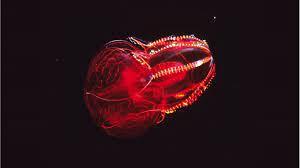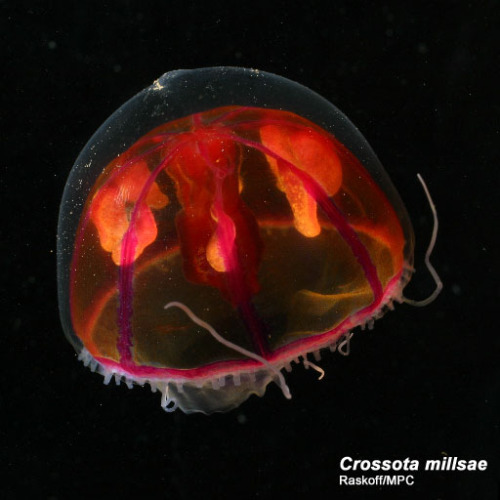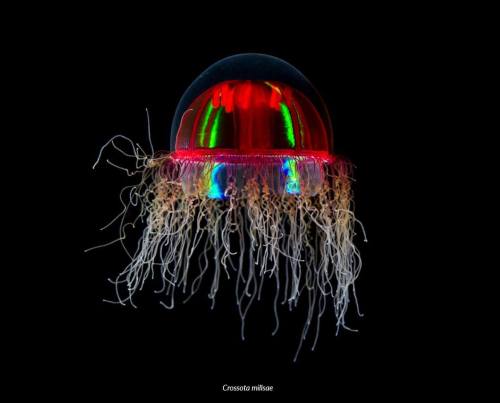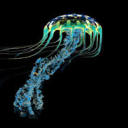Jewel Squid


Jewel Squid
Histioteuthis heteropsis
The Jewel Squid is covered in color-changing photophores that resemble sparkling gem stones. They also have a light-red coloration and are about 20 cm in length. They display a unique behavioral adaptation called diel migration. During the day, they stay at depths around 400-1200 m, and then surface during night (0-400m). This behavioral pattern is designed maximize feeding at night, and avoid predators during the day. The primary predator of the Jewel Squid is the Sperm Whale.
Photo credit: https://www.pinterest.com/pin/722827808920240115/
https://twitter.com/theoctonation/status/1168516522270253056
More Posts from Bioluminescentoceangoddess and Others
An amazing glowing ctenophore!


Bloody-belly comb jelly
Lampocteis cruentiventer
The Bloody-belly is a 16 cm ctenophore that is found at depths 700 m to 1200m. It is crimson red in color and appears black in the deep ocean. However, the jelly has the ability to emit a different color. Furthermore, it uses highly iridescent ctenes to propel through the water.
Photo credit: https://laughingsquid.com/bloody-belly-comb-jelly/
https://www.reddit.com/r/deepseacreatures/comments/2j1717/bloodbelly_comb_jelly_lampocteis_cruentiventer/


Wolftrap Angler
Thaumatichthys binghami
The Wolftrap Angler is slightly different from many other species of anglers. It has its bioluminescent lure located inside of its mouth instead of connected to its body. Even though it is intimidating up close, it is only nine centimeters in size. It is found in the deep ocean at 2432m.
Photo credit
https://en.wikipedia.org/wiki/Thaumatichthys_binghami
https://igniteyourcuriosity.wordpress.com/2016/10/22/anglerfish/
Pyrocystis fusiformis is a common plankton that produces bioluminescence. Not exactly a marine animal, but an amazing organism that produces bioluminescence. So, I thought it was worth sharing on this page.



Pyrocystis fusiformis
Pyrocystis Fusiformis is a marine dinoflagellate that is non-motile and has a short life cycle (5-7 days). When disturbed, the dinoflagellate displays vibrant, blue bioluminescence. The bioluminescence is design to startle grazers, or cause them to glow, making them more vulnerable to predators. During the day, it uses photosynthesis to produce its own food, and it produce bioluminescence at night. Furthermore, it fixes carbon from the ocean and produces oxygen for the marine animals that live there. All in all, I find this diamond shaped plankton to be unique and beautiful.
Photo credit: https://fineartamerica.com/featured/2-bioluminescence-of-pyrocystis-fusiformis-gerd-guentherscience-photo-library.html
https://exploringtheinvisible.com/2013/11/21/c-mould-new-acquisition-pyrocystis-fusiformis/
https://www.flickr.com/photos/13084997@N03/32823053106


Psychedelic Medusa
Crossota millsae
The Psychedelic Medusa is a deep-sea hydrozoan that is abundant in the North Pacific. The mini-jelly is found at depths between 1000m to 3800m, and are often observed drifting near the ocean floor. It also has an eccentric reproduction behavior uncommon in cnidarians. The females display viviparity, and carry the babies in her bell until they are ready to hatch.
Photo credit: http://www.arcodiv.org/watercolumn/cnidarian/Crossota_millsae.html
https://twitter.com/spothvegr/status/1030177493075079169

Marrus orthocanna
Marrus orthocanna is a deep sea siphonophore found at depths between 400m to 2200m. It has a colony of gas-filled zooids on the top used for locomotion. It also has a long, bright orange tentacles on the bottom. Marrus orthocanna are viscous predators and consume small crustceans and copepods.
Photo credit: http://www.arcodiv.org/watercolumn/cnidarian/Marrus_orthocanna.html


Basket Star
Gorgonocephalus caputmedusae
The Basket Star is a strange yet elegant creature that lives in the deep ocean. It resembles a flesh white ball with gnarled and swirling branches. It thrives in locations with strong currents. Its numerous arms move slowly and wrap around prey. They are one of my favorite animals from the Echinodermata phylum.
Photo credit
https://link.springer.com/article/10.1007/s00227-005-0032-3
https://en.wikipedia.org/wiki/Gorgonocephalus


Sea elephant
Carinaria japonica
The Sea Elephant is a translucent sea snail that has a large muscular body and a tiny triangular shell. Its foot is used for crawling on the ground, and it can be transformed into a fin that is used for swimming. It is called the “sea elephant” because it has a small trunk in its mouth that is used to swallow prey. Furthermore, the Sea Elephant eats arrow worms and jellies.
Photo credit
https://bodegahead.blogspot.com/2014/12/carinaria-part-2.html
http://tolweb.org/Carinaria_japonica/28750


Mid-water Arctic Hydrozoan
Botrynema brucei
The Mid-water Arctic Hydrozoan is a mini-jelly that is transparent with hints of blue. It thrives in freezing cold temperatures and drifts aimlessly in the Artic Ocean. Moreover, it is only 3 cm in size and floats between 900m to 2,600m.
Photo credit: https://en.wikipedia.org/wiki/Botrynema_brucei
http://www.arcodiv.org/watercolumn/cnidarian/Botrynema_brucei.html


Gulper Eel
Saccopharynx sp.
The Gulper Eel is known for its massive jaws, which are capable of swallowing prey whole. It’s stomach is also able to expand twice its size. It is found only in the deep see about 2000 to 3000 meters in depth.
Photo credit: https://www.youtube.com/watch?v=XRO0IjSoHGA
https://marinebiochemistrygc2018.weebly.com/deep-sea-adaptations

Scaly Dragonfish
Stomias Boa
The Scaly Dragonfish is about 32cm long and found at depths between 200 to 1500m. The long purple barbel on its chin is used to lure in prey. When the pery gets close enough, it swings its jaws forward swallowing the prey whole.
Photo credit: https://alchetron.com/Stomias
Video on the fish: https://www.youtube.com/watch?time_continue=69&v=9oB_61aI2iQ&feature=emb_title
-
 mawsteeth liked this · 2 years ago
mawsteeth liked this · 2 years ago -
 hmmmmho liked this · 3 years ago
hmmmmho liked this · 3 years ago -
 wannabe-etymologist reblogged this · 3 years ago
wannabe-etymologist reblogged this · 3 years ago -
 wizz-master liked this · 3 years ago
wizz-master liked this · 3 years ago -
 astrotracksuitbattalion liked this · 3 years ago
astrotracksuitbattalion liked this · 3 years ago -
 acolorcollective liked this · 3 years ago
acolorcollective liked this · 3 years ago -
 rustedskyprisms liked this · 3 years ago
rustedskyprisms liked this · 3 years ago -
 808beat reblogged this · 3 years ago
808beat reblogged this · 3 years ago -
 despair-with-walnuts liked this · 3 years ago
despair-with-walnuts liked this · 3 years ago -
 808beat liked this · 3 years ago
808beat liked this · 3 years ago -
 in-soft-grass liked this · 3 years ago
in-soft-grass liked this · 3 years ago -
 windyboysworld liked this · 3 years ago
windyboysworld liked this · 3 years ago -
 balsamic--vinegar liked this · 3 years ago
balsamic--vinegar liked this · 3 years ago -
 eidola-eidola reblogged this · 3 years ago
eidola-eidola reblogged this · 3 years ago -
 levuna liked this · 3 years ago
levuna liked this · 3 years ago -
 jayvalentine liked this · 3 years ago
jayvalentine liked this · 3 years ago -
 spunch-bopp liked this · 3 years ago
spunch-bopp liked this · 3 years ago -
 oniongarlic reblogged this · 3 years ago
oniongarlic reblogged this · 3 years ago -
 amalia-uwu liked this · 3 years ago
amalia-uwu liked this · 3 years ago -
 jovialgardendreamer liked this · 3 years ago
jovialgardendreamer liked this · 3 years ago -
 lovesick-bitchcraft liked this · 3 years ago
lovesick-bitchcraft liked this · 3 years ago -
 jadenja liked this · 3 years ago
jadenja liked this · 3 years ago -
 lpetticoat-blog liked this · 3 years ago
lpetticoat-blog liked this · 3 years ago -
 cannabowlistic reblogged this · 3 years ago
cannabowlistic reblogged this · 3 years ago -
 sabinekarl liked this · 3 years ago
sabinekarl liked this · 3 years ago -
 empathwitchliv reblogged this · 3 years ago
empathwitchliv reblogged this · 3 years ago -
 myriadstrangewood liked this · 3 years ago
myriadstrangewood liked this · 3 years ago -
 belovedantinous reblogged this · 3 years ago
belovedantinous reblogged this · 3 years ago -
 alguac1l liked this · 3 years ago
alguac1l liked this · 3 years ago -
 romero74 liked this · 3 years ago
romero74 liked this · 3 years ago -
 comeoffage reblogged this · 3 years ago
comeoffage reblogged this · 3 years ago -
 sweet-sea-monster reblogged this · 3 years ago
sweet-sea-monster reblogged this · 3 years ago -
 recovery-witch liked this · 3 years ago
recovery-witch liked this · 3 years ago -
 woahcoolbug reblogged this · 3 years ago
woahcoolbug reblogged this · 3 years ago -
 zestyatbest liked this · 3 years ago
zestyatbest liked this · 3 years ago -
 cherry-cola-beagle liked this · 3 years ago
cherry-cola-beagle liked this · 3 years ago -
 deliciously-yeeted liked this · 3 years ago
deliciously-yeeted liked this · 3 years ago -
 ash-the-nekogirl reblogged this · 3 years ago
ash-the-nekogirl reblogged this · 3 years ago -
 ash-the-nekogirl liked this · 3 years ago
ash-the-nekogirl liked this · 3 years ago -
 natsumiikan liked this · 3 years ago
natsumiikan liked this · 3 years ago -
 beatificent liked this · 3 years ago
beatificent liked this · 3 years ago -
 edgeworst reblogged this · 3 years ago
edgeworst reblogged this · 3 years ago -
 morthyew reblogged this · 3 years ago
morthyew reblogged this · 3 years ago

Bioluminescence is a chemical reaction that produces light. Many deep sea animals use bioluminescence. This blog is dedicated to educating the public about the amazing creatures that thrive in the deep sea.
57 posts